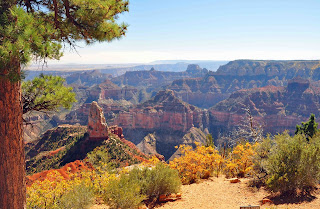 |
| Bob and Linda, start of our journey, Maine Coast, July 2015 |
We have a WONDROUS country! It is beautiful and expansive and diverse (we
are talking about nature’s diversity).
In most cases, the splendor of our natural resources has far exceeded
our expectations. The National Park
Service does an incredible job in preserving, conserving and protecting (and
improving access) to these precious resources, many times in spite of limited
resources and ever increasing crowds. We
have seen a significant increase in the number of visitors, campers and RVs in
just three short years, and we fear for the future impact of the not-yet-retired
baby boomers as they shortly “hit the road”.
The sheer numbers will be simply overwhelming to many of these parks and
resources. We feel fortunate to have
seen them at this time. Go sooner rather than later.
We are SO grateful to the
many people who have often dedicated their lives to the preservation and
conservation of these precious resources, and to the government officials who
supported those efforts. We especially
are grateful to Teddy Roosevelt who did more to preserve and protect these
resources than any other president, and Franklin Roosevelt who dedicated many
more. We learned how important it was
for one individual or small group of dedicated people to envision, drive and
push hard for the formation of many national parks, monuments, etc. In some cases, there was some local opposition,
but it appears that over time, most of this opposition declines and the parks
were ultimately welcomed. We are
certainly thankful for their patience and persistence.
In addition to the natural
beauty of our country, we have learned a lot more about our incredible history,
spectacular geology and natural resources. We think that the NPS has done a
great job in giving insight into the often untold stories about the people and
circumstances for the location and/or event.
Most of the time, the stories are about average Americans, who become
heroes/heroines when put into unusual circumstances. It is the story of each of us, of
Americans. We were very impressed
by the tenacity, ingenuity and courage of miners, lumbermen, cattlemen, settlers
and all those who developed our great county; however, we were saddened to see
how, sometimes, these same people did not understand the long term impacts of
overusing and abusing the land and resources.
Having lived near the 1849ers gold mining in the Sierra Nevada, we used
to say “Thank God the miners did not have bull dozers or there would be no
Sierra mountains left”. We think the NPS
and Government in general are doing a good job in restoring much of this earlier
damage – but it takes a long, long time (perhaps a rare example of good “bigger” government).
 |
| Bob's 73rd, Coeur d' Alene, August 2017 |
We have spent a lot of
time talking to our “neighbors” all across the country. We have visited innumerable numbers of
American Legions and Elks Lodges every place we could find them. We have learned from locals a lot about their
history and economies….many towns are struggling to find a new economy as many
of the “old” 20th century economic drivers are no longer available: fossil fuels (although there are some new
renewable energy drivers and newer oil fracking, etc), lumbering and wood products, manufacturing,
mining, etc. The usual default is to become a “cute” historic town to try to
attract tourism, but there is only so much of that which can go around
successfully.
Unfortunately, gambling
casinos are becoming incredible prolific – it seems sad to us that they must be
successful as more and more are being built.
There have been some excellent success stories, but shuttered, deserted
store fronts are all too common. In
spite of this, most people are upbeat and positive about the future of our
country. Many people are even returning
to the towns they grew up in, but most are driven by a return to be with family. Grandparents moving to be near grandkids has
been a consistent, pervasive theme.
We have also learned a lot
more about American history, including some of our history that is not so noble; but that history
is also very important. It is
unfortunate that today’s politically correct culture wants to erase some of our
history, because it is not consistent with today’s standards. How will future Americans
look at what we are doing today? Will
they want to erase some of our current events because it is not consistent with
their future cultural lens? We must
preserve the past, good and bad, in order to not repeat our mistakes. “Those who cannot remember the past are
condemned to repeat it.” - George Santayana, 1863. America is still one of the greatest places
to live today, for whites and non-whites.
One last thought, if we
had a penny for every person who said “You are living my dream” we could have
traveled for free, particularly after we add our sailboat cruising stories. Our message: PLEASE do not wait too long to
follow your dream – whatever that is. We
have heard from too many people who can no longer travel because of health or
family issues. Do what you can while you
can…. Life can be too short and you do
not know how long you have to be able to fully enjoy it.
For those who have not
read out travel blogs, but would like to, the link is www.RVRamblin1.blogspot.com
We are so grateful and
feel very blessed to have been able to travel and learn all we have over the
past three years (and the five years of cruising prior to that). We thank GOD for these blessings and the
opportunity to share this with you.
May God Bless You and your
family and give you the opportunity to follow YOUR dreams. We wish you all a wonderful holiday season
(and a Merry Christmas), and a healthy and prosperous New Year.
We welcome your feedback
about our travel stories and our blog as well as hearing about your
adventures. We would like to live
vicariously through your adventures and your life as we try to find our perfect
place to settle down…somewhere, again.
Please share your adventures with us.
Linda and Bob
SOME STATISTICS ABOUT OUR THREE-YEAR ADVENTURE
Cumulative 3 Years (and Lifetime)
Months Traveling on Road 21 (5/15 to 12/17)
RV miles (point to point) 33,600
Car miles (touring each
area) 41,600
Total Miles Driven 75,200
Number of States 45
out of 50 on this trip (all 50 in total)
Number of RV Ramblin
Blogs 35
US National
Parks (59 total) 40 (have visited 55 of 59 over the years – 100% in lower 48) (not
visited 3 fly-in only above Arctic Circle & 1 in Am Samoa)
US National Monuments
(129) 72 (91 in total)
US Ntl Natural Landmarks
(559) 41 (93 in total)
US Ntl Historic
Parks (51) 11 (32 in total)
US National Historic Sites
(89) 9 (18 in total)
US Ntl Recreation Areas
(18) 8 (13 in total)
US Ntl Grasslands/Prairie
(21) 6
US National Seashore (10) 6 (all 10 over
the years)
US National Lakeshores (4) 4 (100%)
US National Memorials (30) 3 (21 in total –
mostly in DC)
US National Preserves (21) 2 (10 in
total)
US Ntl
Battlefields/Military Pks (25) 1 (8 in total)
US National Rivers (15) 1 (4 in total)
Note: There are a total of 417 National Park
Service Units
Canadian National Parks
(39) 16







































